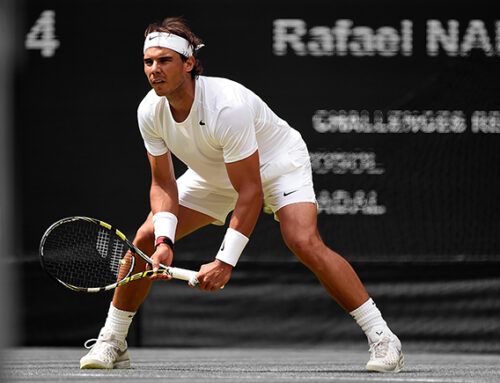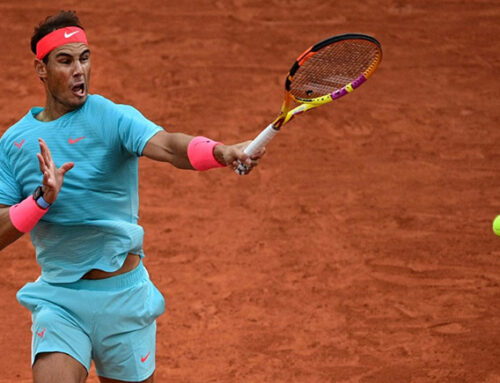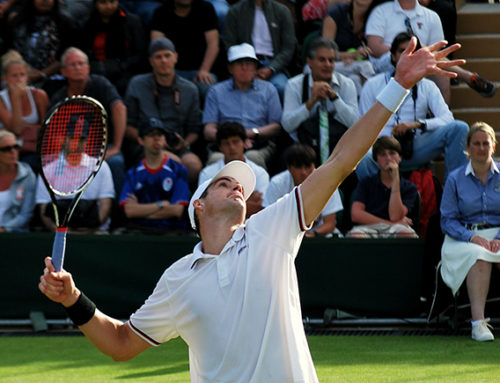The Hopman Cup, named for legendary Australian Davis Cup Captain Harry Hopman, is little more than an international glorified exhibition tournament. Featuring two-person teams (one player of each gender) from eight different nations, the round-robin format allows for some guaranteed matches leading into the start of the tennis season. Given the laid-back nature of the affair, Bernard Tomic’s straight set defeat of Novak Djokovic earlier today will hardly send shock-waves through the world of tennis. It may however, cause at least a ripple. After a promising start to his professional career with a quarter-final run at Wimbledon in 2011 (where he lost in 4 sets to eventual champion.. Novak Djokovic), Tomic took a rather large step backwards in 2012 where his poor on-court performance wasn’t helped by off-court drama such as a bizarre stand-off with Australian police and another incident involving Tomic fighting his friend and also possibly police in October. With the year ending so poorly for the young Australia, the shock victory over Djokovic brings us to the topic of today’s update:
Is Bernard Tomic’s Hopman Cup win over Djokovic more accident or omen? Was this a fluke victory over a sub-par Novak in a meaningless exhibition, or is Tomic primed to take his tennis career to the next level in 2013?
We’re going to make three quick assumptions about Djokovic’s role in this before we begin.
1. Djokovic has prepared but not peaked. That is to say, he’s physically healthy, winding down his heavy physical prep in anticipation of the Aussie Open, but he is neither match-tough nor peaking – exactly the same state Tomic should be in.
2. Djokovic played to win. Knowing the effect of his 2011 winning streak on his career, Djokovic believes in a habit of winning. He’s not going to play even the Hopman Cup half-heartedly as he wants that aura of invincibility back.
3. No matter what this means for Tomic, it isn’t a bad indicator for Novak. Tomic has shown he’s dangerous to top players in the past, and by no means are we anticipating a poor year for Djokovic.
Breaking Down Tomic’s Game
We’re going set Djokovic aside now, and instead take a look at Tomic’s game. What does the 6’5 Australian bring to the court? In order to do so we’re going to look at five different aspects: physical, groundstrokes and volleys, serve, mental and tactical. By the end, we’ll have a good overview of Tomic’s tennis skills as they pertain to his ability to win at the top level of the pro tour, and if we don’t have all of the answers we can, at the very least, be asking the important questions and giving you some idea of what to look for from Tomic over the coming year.
Physical
At 6’5 and pushing 200 lbs, Tomic should cut an imposing figure on the court. However with his slightly rounded shoulders, barely-there-pecs and general posture he is cut from a very different cloth than the gargantuan (yet ironically fragile) Mark Philippoussis. For his size, Tomic moves and defends the court quite well. He is far more agile than similarly sized Tomas Berdych (who stands the same height and an almost identical weight). However despite this agility, he will not be confused with Gael Monfils either – he lacks not only the Frenchman’s skin pigment, but also his explosiveness both on the jump and the first step to the ball.
It is hard to speak conclusively about Tomic’s conditioning in the way we can about many other players. He is so young that there simply isn’t enough data there to draw solid conclusions. The knock on Tomic is that he has not been willing to work hard, especially since his successes in 2011. There may be something to that – his poor on-court demeanor certainly belies a lack of emotional maturity and mental discipline. There is also a fairly strong correlation between physical preparedness and ‘tanking’. Tomic caught a lot of negative attention last year for a perceived lack of effort in several matches – something that has dogged him throughout his short career. Way back in 2007 he had his junior funding cut for tanking a match at the 2007 French Open juniors. He walked off the court mid-match against fellow Australian Marinko Matosevic in 2008 during a professional match, earning himself a one-month suspension. Then Tomic’s effort (or lack thereof) in late 2012 led both to his being dropped from the Australian Davis Cup team, and for the Australian Davis Cup Captain Patrick Rafter to open criticize him in the media.
While Tomic doesn’t really look any fitter or stronger at the Hopman Cup, his build makes it very hard to discern differences compared to last year. He has spoken in post-match interviews about the hard work he’s put in since the end of the 2012 season, and he certainly looked more composed and ready to fight against Djokovic than he did in many matches last year.
Groundstrokes and Volleys
Tomic has an unusual game for a professional player, and it all begins with his forehand. In an age of hissing topspin, Tomic’s forehand isn’t just ‘flat’ in comparison to most of his peers, it often comes back over the net with sidespin on it. This is a result of a very low angle of attack on the ball, and the way he actually slides the stringbed across the back of the ball from right-to-left. The result? A low ball that skids through the court. It is below the ideal strike zone of almost every male player on tour, which means it is hard for them to attack the ball the way they are used to. In addition Tomic also plays a significant number of genuine slice (underspin) forehands. He has the ability to slide his forehand up the line with excellent disguise. When he does so the sidespin he imparts on the ball moves it slightly away from the incoming opponent, and the low skidding trajectory makes it very difficult to handle. This is probably Tomic’s most dangerous shot on the court.
Although Tomic’s two-handed backhand is pretty standard fair, he does possess a very good one-handed slice backhand. Combined with his unusual forehand, Tomic plays through a very unique space on the court that is unsettling to many players. There are frequent changes of pace to his groundstroke play. Combine this with the unusual spins and relatively low height of shot and he is a different prospect to face and one that is hard to prepare fore.
Volleys are lumped in here because there really isn’t enough to say about Tomic’s volleys for them to warrant their own section. He comes in to the net occasionally, and is competent up there. His volleys are neither outstanding in the vein of Patrick Rafter, nor terrible in the sense of Andre Agassi or early-career Andy Roddick (who became quite competent by the end of his career).
Serve
Here we have our first aspect of Tomic’s game that is lacking. It isn’t that he has a bad serve, per-se. Rather, his serve is merely mediocre. His velocity tops out around 125 mph (give or take 1-2 mph), and his second serve is respectable without being exceptional. And there is the problem. As a 6’5, 200 lb man Tomic’s frame promises at much more than Tomic is actually accomplishing. His service motion really is in many ways a lesson in biomechanics – the early opening of the hips combining with the jack-knife bending of his torso at the waist are two glaring aspects in dire need of correcting for him to achieve velocity befitting his size.
However in his favor Tomic does possess excellent accuracy, and he moves the ball well with variety. It is a shame because if he had access to another 5-10 mph on his first serve, all of his other off-pace, higher-spin deliveries would be that much more effective. So Tomic’s serve goes down as a strength, but a significantly weaker one than it should be given his size.
Tactics
Tomic brings a very unusual set of technical skills to the court for his matches and they culminate in some unusual tactics. Commentators have, in the past, described Tomic’s game as something of a rope-a-dope. For those not familiar with the term, it means he almost lulls opponents into a sense of false security by offering just enough resistance to get by, then striking when they don’t expect it. As an example, Tomic traditionally plays very passively in the center of the court. While most pros look to control the center of the court and hit outwards towards the sidelines and make their opponents run, Tomic’s standard fare has been instead to play low trajectory, low-pace, sidespin balls almost directly up the middle, denying his opponents any angles off which to attack him. He will do so waiting until they either make an error, or push him wide into a corner on the run. Then he will suddenly dramatically increase his pace of shot, and hit either for the opposite corner or down the line.
In essence he has played as a 6’5 counter-attacker. There is a sense of almost genius in it – an intuitive sense of risk versus reward that many players inherently lack. Fernando Verdasco is one example of a player who has a ton of weapons in his arsenal but generally speaking a very poor sense of when to use which. Verdasco pulls the trigger at completely inappropriate times during rallies. Tomic on the other hand has traditionally avoided risk where-ever possible. He puts himself in low-risk positions in the center of the court, forcing his opponents to take the initiative. Then, when they do, he tries to hurt them through the openings they have created with their aggression. Put this together with a game of unusual spins and frequent changes of pace – a style of play that will naturally draw more unforced errors from an opponent than usual – and you’ve got a player who can be hard to beat.
All of this does come at a price however, and that is something we will deal with in a few paragraphs when we look forward to what Tomic needs to do this year to break through.
Mental
Given Tomic’s off-court troubles, and some of the bizarre behavior he has shown on-court, this is the area where the most question marks about Tomic exist. Who walks off the court in the middle of a professional match? He has been remarkably unprofessional in his approach to professional tennis as a whole. And therein lies the problem. It is not a question of whether or not he can handle on-court pressure. He had great success as a junior, winning multiple junior grand slam titles and has been playing in professional tournaments since he was 15 years old. He’s played some fantastic tennis on the big stage – his Wimbledon performance being a great example as he became the youngest man in the Wimbledon quarter-finals since Boris Becker back in 1985.
Tomic does not suffer from a lack of belief. As recently as late last year in response to some of the criticism he received for his behavior he said “I’ll prove that I’m going to be the tennis player one day to have played this game”. It isn’t his first time proclaiming himself the future Greatest Of All Time and may not be the last. But his this confidence, or false bravado? Does Tomic really believe himself a future talent greater than Federer, Nadal, Sampras, or Laver? Or is he instead putting up a facade, a mask for the world while inside he self-destructs to avoid the pressure of actually having to perform? Is he instead creating his own excuses with his behavior for not reaching his talent?
What Does Tomic Need To Do?
So let’s get down to the heart of it. What does Tomic need to do in order to genuinely break into the top ranks and compete for #1 in the world? That’s his stated goal, so it would be a dis-service to his inflated ego to look at his game in any other light. Here’s our short list of things Tomic must do in order to have a sustained break-through in 2013:
1. Take The Initative. While the others may not be in order, this is listed first for a reason. Tomic has played too passively as a whole on the pro tour. While it may work against lower-ranked opponents, his rope-a-dope style simply does not work against top-caliber opponents. Federer, Djokovic, Berdych… the top players all have enough weapons that by waiting for them to make the first move, Tomic hands away initiative to players who simply won’t give it back. Tomic may hit best on the run, but he’s not alone in that regard and if you think you can give Federer a forehand in the middle of the court and win the point close to 50% of the time then you’re sorely mistaken. He HAS to strike first more often, look to spread the court and initiate play.
2. Improve His Serve. It’s a serviceable delivery but if he wants to genuinely compete at the top of the game he has to do more with it. Tomic has to work with a genuine coach who understands service mechanics. Nadal was humble enough to see a specialist to tweak his serve and Tomic needs to do the same. Improved mechanics could easily net him an extra 5 mph and more angle out wide. It could also make his second serve much more effective.
3. Get Fitter, Get Stronger. He needs take a page out of Verdasco’s book a la Christmas 2008. Verdasco spent his off-season that year training with Gil Reyes, Agassi’s old strength and conditioning coach, and came back to tour at the start of 2009 the fittest and strongest he had ever been. No coincidence he then made the only slam semi-final appearance of his career where he lost in 5 to Nadal in one of the best Aussie Open matches ever. It wasn’t just the physical aspect that improved Verdasco’s play – in putting in the hard yards Verdasco came out mentally tougher, too. He was more disciplined in his play, and mentally ready to fight to the end.
4. Hire A Professional Coach. Tomic has been guided by his father for most of his tennis career and that road is at a dead end. Despite his obvious talents, Tomic’s technique is lacking in some areas and he needs the guidance of someone who has a long history of coaching on the professional tour. As stated earlier, Tomic’s approach to the professional game has been unprofessional. Someone like Larry Stefanki, Brad Gilbert or Darren Cahill might be an obvious choice. But then there are names like Sven Groenveld who have been around the tour for an eternity, who know the game well and could do a great job with someone of Tomic’s talent.
5. Find Humility. It isn’t that we don’t want Tomic having confidence. It’s that he needs to learn when and how to show it to the world. When you talk about being the greatest player ever, then tank early rounds at Grand Slam tournaments that isn’t showing confidence. That’s being brash. Tomic needs to learn to shut his mouth and show the world his self-belief by investing in himself. By putting everything he has into his tennis, putting everything he has out on the court and not being afraid to fail. That’s confidence. Until then, he should realize he’s burning bridges by running his mouth and his father is burning others for him.
Will Tomic be great? He has technical hurdles to overcome but nothing that is insurmountable. He has the capacity for greatness within him. The question really is whether or not he can do greatness. Tomic will never win 18 Grand Slam titles. But a handful are certainly within his reach if he’s willing to do the work and play the way he needs to in order to reach his goals. Look for him to take any of the 5 steps listed above to begin his journey. Otherwise expect another frustrating year of wasted talent.


